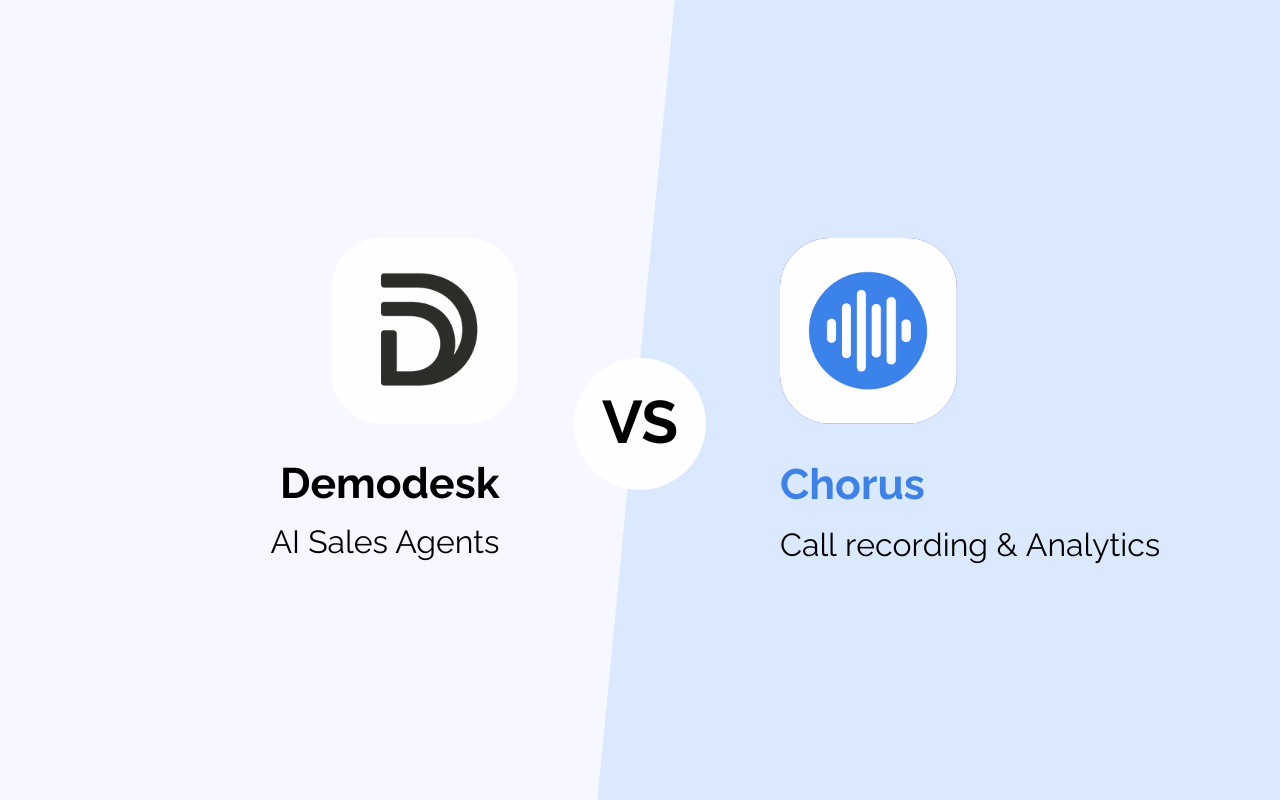When it comes to conversation intelligence platforms, both Chorus and Demodesk aim to help revenue teams capture customer conversations, surface insights, and improve sales performance.
But as sales technology evolves toward agentic AI, systems that not only analyze data but act on it, the difference between observation and automation becomes decisive.
Executive Summary
Chorus, now part of ZoomInfo, helped define the early conversation intelligence category. It records and analyzes calls to provide coaching insights and deal visibility.
Demodesk, on the other hand, represents the new generation of AI sales technology, AI Sales Agents that work alongside revenue teams to capture, understand, and act on every customer interaction automatically.
Many teams that switched from Chorus to Demodesk shared similar pain points: while Chorus provided solid conversation recording and analytics, it often fell short in usability and flexibility. Customers described Chorus’s interface and reporting tools as unintuitive, making it challenging to extract meaningful insights quickly. GTM leaders found themselves exporting data to spreadsheets or building manual dashboards to get the reporting depth they needed, an unnecessary friction point in fast-moving sales environments.
For teams scaling globally and moving fast, Demodesk turns meetings into motion.
Scoring Methodology
We applied a 0–1–2 scoring framework across seven feature domains essential to GTM and revenue organizations:
- 2 points: Clear leader or best-in-class
- 1 point: Functional but limited
- 0 points: Missing or underdeveloped
Overall Score Summary
| Feature Domain |
Demodesk |
Chorus |
| Conversation Capture & Understanding |
16 |
13 |
| AI Actions & Follow-Up |
12 |
6 |
| Coaching & Performance Optimization |
10 |
8 |
| Pipeline & Revenue Intelligence |
12 |
6 |
| CRM Automation & Data Accuracy |
10 |
4 |
| Integrations & Platform Connectivity |
10 |
8 |
| Security & Administration |
12 |
9 |
| Total |
82 |
54 |
🏆 Winner: Demodesk — for its end-to-end, agentic AI built to act, not just analyze.
1. Conversation Capture & Understanding
| Sub-Feature |
Demodesk |
Chorus |
Notes |
| Multi-platform recording |
2 |
2 |
Both support Zoom, Meet, and Teams |
| Instant access after meeting |
2 |
2 |
Transcripts available shortly after calls |
| Recording import capabilities |
2 |
1 |
Demodesk allows upload and merge of external recordings |
| Central recording library |
2 |
2 |
Organized repository for all meetings |
| Bookmarking & commenting |
2 |
2 |
Collaborative timestamping supported |
| Multi-language transcription |
2 |
0 |
Chorus limited for EMEA; Demodesk supports 98+ languages |
| AI-generated summaries |
2 |
2 |
Both offer automated summaries |
➡️ Key Difference:
Demodesk’s transcription engine is multilingual, GDPR-compliant, and customizable — ideal for global teams. Chorus’s single-language focus limits adoption outside English-speaking markets.
Pricing also emerged as a significant barrier. Several customers highlighted that Chorus’s cost structure seemed high relative to its functionality, especially when compared to newer AI-driven platforms that offer automation and CRM connectivity at a lower price point. For global teams, particularly in EMEA, limited language support was a consistent frustration. Chorus’s transcription and analysis capabilities struggled with non-English conversations, which made adoption uneven across regions.
2. AI Actions & Follow-Up
| Sub-Feature |
Demodesk |
Chorus |
Notes |
| AI follow-up generation |
2 |
1 |
Demodesk automates personalized follow-ups; Chorus limited |
| AI CRM filling |
2 |
0 |
Demodesk updates CRM fields automatically |
| AI summary generation |
2 |
2 |
Both summarize; only Demodesk syncs to CRM |
| AI task creation |
2 |
1 |
Demodesk generates action items automatically |
| AI Assistant Chat |
2 |
0 |
“Ask AI Assistant” enables natural-language queries in Demodesk |
| Auto-distribution |
2 |
2 |
Both share summaries and clips; Demodesk routes contextually |
➡️ Key Difference:
Chorus captures information.
Demodesk acts on it, drafting emails, updating CRM, and distributing next steps without manual effort.
Operationally, users pointed to gaps in CRM integration and flexibility. Chorus lacked robust support for custom objects and advanced CRM workflows, leading to partial or manual data syncing between systems. For organizations running Salesforce or HubSpot at scale, this meant extra administrative work and a loss of data accuracy. Many also noted the platform’s lack of modularity and customization, with rigid product configurations that didn’t adapt easily to different team structures or sales motions.
3. Coaching & Performance Optimization
| Sub-Feature |
Demodesk |
Chorus |
Notes |
| AI scoring & feedback |
2 |
2 |
Both support AI-driven scoring |
| Manual scoring |
2 |
2 |
Human scoring available in both |
| Deal health insights |
2 |
1 |
Demodesk pulls real-time CRM context |
| Performance dashboards |
2 |
1 |
Demodesk customizes reports. |
| Conversational metrics |
2 |
2 |
Both track talk ratios, keywords, and engagement |
➡️ Key Difference:
Chorus provides general coaching analytics.
Demodesk offers sales methodology–based AI coaching, adapting scorecards to MEDDIC, BANT, or custom frameworks.
4. Pipeline & Revenue Intelligence
| Sub-Feature |
Demodesk |
Chorus |
Notes |
| Meeting-level analytics |
2 |
2 |
Both analyze meeting performance |
| Pipeline health monitoring |
2 |
1 |
Demodesk automatically flags stalled or at-risk deals |
| Market trend detection |
2 |
0 |
Unique to Demodesk |
| Product feedback extraction |
2 |
0 |
Chorus lacks automated feedback categorization |
| Performance metrics |
2 |
2 |
Both offer high-level performance views |
| Natural-language analytics |
2 |
0 |
“Ask AI Analyst” enables instant insight queries |
➡️ Key Difference:
Chorus identifies deal patterns.
Demodesk translates meetings into pipeline visibility and GTM insights automatically.
5. CRM Automation & Data Accuracy
| Sub-Feature |
Demodesk |
Chorus |
Notes |
| Zero-setup CRM integration |
2 |
1 |
Chorus requires elaborated setup; Demodesk connects instantly |
| AI object detection |
2 |
0 |
Demodesk auto-creates leads, contacts, and opportunities |
| AI field suggestion |
2 |
0 |
Demodesk suggests updates based on conversation data: 99% accurate |
| Human-in-the-loop approval |
2 |
2 |
Both allow validation for CRM updates |
| Real-time sync |
2 |
1 |
Demodesk instant; Chorus periodic |
| Custom object support |
2 |
0 |
Chorus lacks advanced object sync; Demodesk supports CRM custom objects |
➡️ Key Difference:
Chorus integrates with CRMs.
Demodesk operates within them, using AI to ensure data is clean, complete, and current.
6. Integrations & Platform Connectivity
| Sub-Feature |
Demodesk |
Chorus |
Notes |
| Calendar integrations |
2 |
2 |
Both integrate with Google and Outlook |
| CRM platforms |
2 |
1 |
Demodesk connects natively to Salesforce & HubSpot |
| Video conferencing |
2 |
2 |
Both support major meeting tools |
| Dialer integrations |
2 |
1 |
Demodesk supports Aircall, Talkdesk |
| API & Webhooks |
2 |
2 |
Both open to developer integrations |
| Modular feature adoption |
0 |
0 |
Chorus lacks modularity; Demodesk allows flexible adoption per team |
➡️ Key Difference:
Demodesk’s integration layer is deeper, faster, and more flexible, ideal for teams scaling across multiple tools and CRMs.
7. Security & Administration
| Sub-Feature |
Demodesk |
Chorus |
Notes |
| Recording permissions & access controls |
2 |
1 |
Demodesk provides granular access management |
| Audit logs |
2 |
2 |
Both offer tracking for compliance |
| Domain control & SSO |
2 |
2 |
Enterprise-level authentication supported |
| GDPR compliance |
2 |
1 |
Chorus compliant but not EU-native |
| Role-based team management |
2 |
2 |
Available in both |
| Premium support & onboarding |
2 |
1 |
Demodesk offers dedicated enablement for GTM teams |
➡️ Key Difference:
Demodesk is privacy-first and EU-built, providing localized compliance for GDPR, which Chorus struggles to match for non-US organizations.
Lastly, some teams raised concerns around confidentiality and control. Without the ability to edit transcripts or redact sensitive information, compliance-conscious companies found Chorus restrictive, especially in industries handling sensitive client data. Combined with its static interface and limited adaptability, these constraints often made Chorus feel like a tool for observation rather than a true enabler of sales execution.
Where Chorus Excels
- Strong conversation analysis and playback capabilities
- Established brand with integration into ZoomInfo ecosystem
- Reliable call analytics for English-speaking teams
Where Demodesk Leads
- Agentic AI that automates CRM updates, follow-ups, and deal insights
- Seamless CRM integration with custom object and HubSpot sync
- Multi-language transcription for global teams
- Customizable AI coaching and prompts aligned to sales methodologies
- User-friendly UI and flexible reporting
Final Verdict
Chorus is a solid analytics tool for understanding what’s happening in your calls.
Demodesk is an AI sales platform built to ensure the correct actions happen next automatically.
For sales and GTM leaders, the choice depends on ambition:
If you want to analyze, go with Chorus.
If you want to accelerate, go with Demodesk.
Demodesk doesn’t just capture conversations: it turns them into revenue.




.png)
.png)
%201.avif)
.png)





